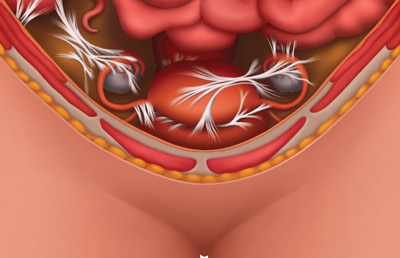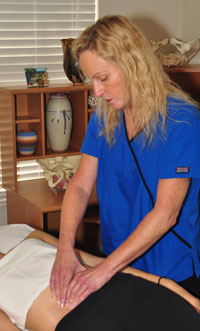
Pelvic pain — pain in the area between the hips and below the belly button — affects roughly half of American women. Yet, many do not know why they have pain and often feel uncomfortable discussing it with their doctor. Read on to learn about three conditions that can cause pelvic pain and the treatment options for each.
Pelvic Adhesions
Cause
Adhesions can form as the body heals from a vaginal or yeast infection, and inflammations from conditions such as pelvic inflammatory disease (PID) or chlamydia. Similarly, adhesions can develop in response to a pelvic surgery such as a C-section, hysterectomy, or myomectomy. Once pelvic adhesions form, they can remain in the body for a lifetime, causing pain and dysfunction.

Treatment Options
Until recently, the only option medical science has offered for treating adhesions has been lysis of adhesions, a surgical procedure in which the surgeon cuts or burns the adhesions. Unfortunately, lysis of adhesions has two major drawbacks:
- The risks associated with anesthesia and infection
- No matter how skilled the surgeon is, the body creates more adhesions as it heals from the surgery designed to remove them.
Clear Passage therapists treat adhesions naturally using a hands-on manual therapy, the Wurn Technique®. Similar to the tiny fibers of a nylon rope, adhesions are made up of individual strands that attach to each other to create powerful bonds or cross-links. Our therapy reduces adhesions by detaching these cross-links.
Endometriosis
Cause
Affecting approximately eight million women in the U.S., endometriosis is a condition in which tissue that normally lines the uterus is found in other areas. The tissue may be found on or near the reproductive organs or within the abdominal cavity. These misplaced endometrial tissues respond to the menstrual cycle as they would in the uterus — by swelling. The result is inflammation, which often results in the formation of adhesions as the body heals from the inflammation.

Treatment Options
Women with endometriosis are typically prescribed drugs to suppress the growth of endometriosis and associated pain. However, these medications tend to act as a temporary fix and many of them interfere with fertility. Minimally invasive surgery may be used to remove or destroy endometrial growths; in severe cases of endometriosis, hysterectomy may be recommended. However, both of these surgical options are associated with the risks and drawbacks outlined in the previous section.
The Wurn Technique treats endometriosis pain by decreasing adhesions without the need for surgery or drugs. Clear Passage therapists use their hands to unravel the bonds that attach endometrial implants to various structures and tissues.
Interstitial Cystitis (IC)
Cause
Interstitial cystitis (IC) is a chronic inflammation of the bladder, described by patients as the worst urinary tract infection you could imagine. Symptoms include chronic pelvic pain; a persistent, urgent need to urinate; frequent urination in small amounts, as many as 60 times a day in severe cases; and intercourse pain.
While no definitive cause of IC has been identified, the condition is thought to be caused by a breakdown of mucin — the cells on the surface of the bladder that protect it from acidity. In addition, the urine of people with IC contains a substance known as antiproliferative factor (APF), which is believed to block the development of cells within the bladder lining.
Treatment Options
While there is no cure for IC, there are ways of managing the symptoms. Unlike urinary tract infections, which are caused by bacteria, interstitial cystitis does not respond to antibiotics. Pentosan polysulfate sodium may be prescribed to reduce pain and urinary frequency, however, pain relief may not occur for two to four months, while a decrease in urinary frequency may not occur for up to six months.
Additional treatment methods include bladder distention (stretching of the bladder using liquid or gas) and bladder instillation, also called a bladder bath or wash. Surgery is a last-resort option typically reserved for IC patients who have ulcers in the bladder. For some, symptoms persist even after surgery.
The Wurn Technique can help alleviate IC symptoms of IC by releasing tissue restrictions caused by the inflammation associated with IC.
If you’d like a free consult, please take 20 minutes and fill out this form and we can determine if therapy would be a good fit for you.


















